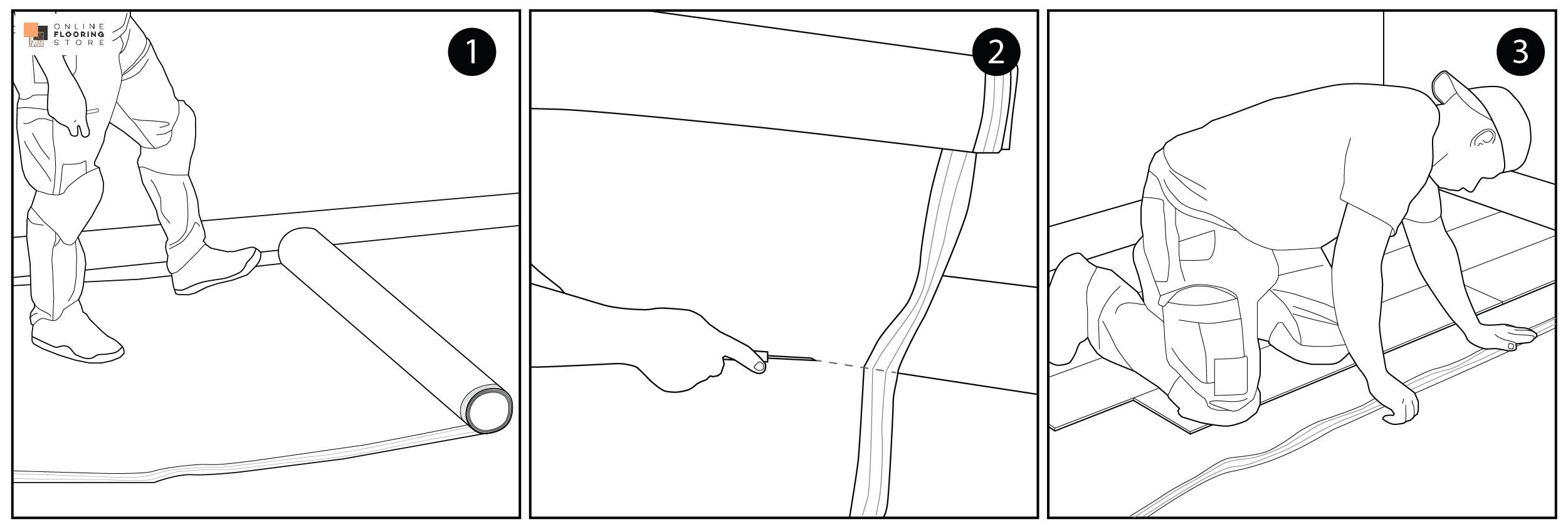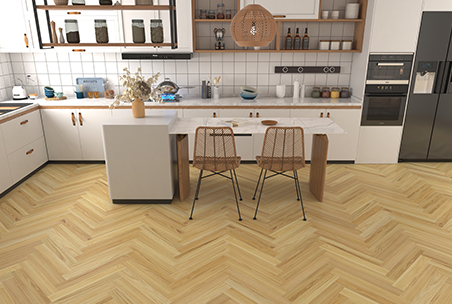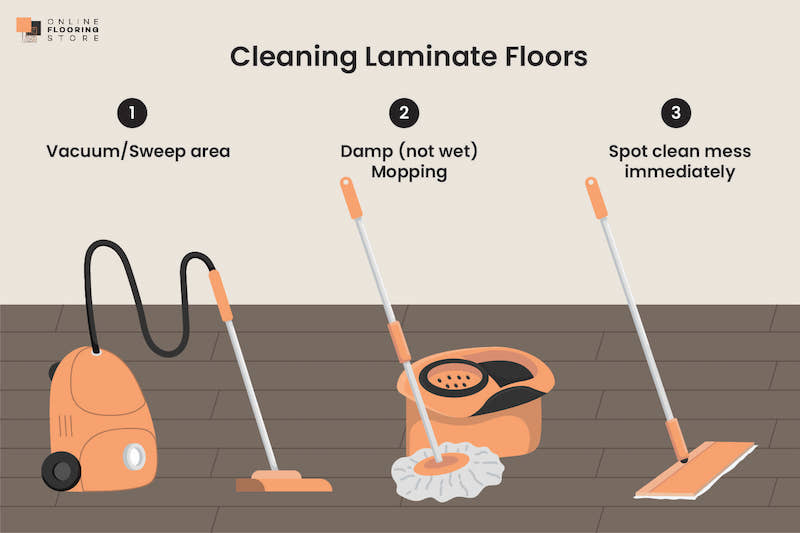If you’re wondering, “Is laminate flooring good?” for your home or commercial space, the simple answer depends on your needs, budget, and location. Laminate flooring offers excellent durability and affordability (typically $25-70 per square metre) with realistic wood appearances, but it can’t be refinished and has moisture limitations in bathrooms and wet areas. Now, let’s dive deeper into what makes laminate flooring worth considering for your project.
What Is Laminate Flooring?
Laminate flooring is a synthetic product that simulates the look of natural materials (primarily timber) through a photographic layer sealed beneath a protective wear layer. It’s become immensely popular for those wanting the luxurious appearance of timber without the hefty price tag or maintenance requirements.
Best Applications
Laminate excels in home offices, media rooms, and dining areas where its scratch resistance and easy maintenance shine. Water-resistant options are recommended for kitchens, while bathrooms require fully waterproof products with careful installation. Below-grade installations demand proper moisture testing and quality vapour barriers to prevent failures from rising damp.
How Laminate Flooring Is Constructed
The Four-Layer System
What is laminate flooring made of? When you examine a cross-section of laminate flooring, you’ll find a clever four-layer construction that delivers both performance and aesthetics:
- Wear Layer – The topmost transparent layer protects against scratches, stains, fading, and daily wear. This tough layer determines how long your floor will maintain its appearance under foot traffic.
- Design Layer – This photographic layer gives laminate its timber-like appearance. Using high-resolution imagery and modern printing techniques, this layer can mimic virtually any wood species, colour or grain pattern with remarkable realism.
- Core Layer – The backbone of laminate flooring, typically made from High-Density Fibreboard (HDF). This layer provides stability, impact resistance and is crucial to the flooring’s overall durability.
- Backing Layer – The bottom moisture-resistant layer that protects the core from humidity from below and helps stabilise the plank.
The Role of High-Density Fibreboard (HDF)
The HDF core truly separates quality laminate from lesser products. Made from wood fibres compressed under high pressure with resins, it provides the structural integrity and density that gives laminate its characteristic durability. When choosing laminate, pay close attention to the core’s thickness and density. Generally, higher-density cores perform better over time and are less likely to swell if exposed to moisture.
Unlike solid timber, which comes directly from harvested trees, laminate flooring is manufactured primarily from composite wood.
What is laminate flooring made of specifically?
The core typically comprises 80-85% wood fibres sourced from fast-growing, sustainable forests, mixed with resins and pressed together. This means you’re getting a product that offers timber aesthetics but with greater eco-friendliness, sustainability, and price efficiency.
The beauty of this construction method is that fake wood flooring (as some might call it) can outperform natural wood in several essential ways, from scratch resistance to stability in changing temperatures. And despite being “fake wooden flooring,” today’s premium laminates are virtually indistinguishable from the real thing to the casual observer.
The Pros and Advantages of Laminate Flooring
Cost-Effectiveness Compared with Natural Materials
Let’s talk dollars and cents, because when it comes to laminate flooring cost, you’re looking at significant savings. Laminate flooring typically ranges from $25 to $70 per square metre for the materials alone, compared to solid timber, which can set you back anywhere from $70 to $130+ per square metre. That’s potentially thousands saved on a whole-house installation!
It’s not just the upfront cost of materials; the cost of laying laminate flooring is also more budget-friendly. Professional installation typically runs between $30 and $40 per square metre, whereas solid timber installation, sanding, and finishing can easily exceed $50 to $70 per square metre. For a small 70m² house, that’s a difference of potentially $2,100 or more in installation costs alone.
Positive Long-Term Value Considerations
While I’m always honest about laminate’s limitations (more on those later), it’s worth noting that good-quality laminate can provide excellent value over its 10-15-year lifespan. With proper care, premium laminate floors will maintain their appearance with minimal maintenance expenses, unlike timber, which may require costly refinishing every 5-7 years, depending on wear.
Exceptional Durability, Scratch and Impact Resistance
I’ve seen plenty of beautiful timber floors ruined by dog claws, furniture legs, and dropped items. This is where wood-look laminate flooring truly shines. The tough wear layer is designed to resist scratches, scuffs, and impacts.
Quality laminates typically achieve AC4 or AC5 ratings for abrasion resistance, making them ideal for high-traffic areas like hallways, kitchens and living rooms. I’ve seen laminate floors in commercial settings withstand years of abuse that would have destroyed a timber floor in months.
UV Resistance and Colour Stability
One of the lesser-known advantages of laminate is its excellent UV resistance. Unlike timber, which will change colour as it oxidises, quality laminate floors maintain their colour consistency throughout their lifetime. This is particularly important in sun-drenched Australian homes with large windows or north-facing rooms. I’ve been in countless dwellings where timber floors show distinct shade differences between areas exposed to sunlight and those covered by rugs or furniture. With laminate, this isn’t an issue; what you see on day one is what you’ll see years later. There is always the slight possibility of fading with laminate, so no supplier or retailer is willing to guarantee against fading.
Performance in High-Traffic Areas
For busy households with kids, pets, or frequent entertaining, laminate’s wear resistance is a genuine game-changer. The aluminium oxide particles embedded in the wear layer create a surface that’s extremely difficult to wear through, even in high-traffic areas.
I’ve recommended the installation of laminate in rental properties where landlords specifically chose it for its ability to withstand tenant turnover without requiring replacement. This is also why you’ll often see fake wood flooring in commercial settings like retail stores and offices, where foot traffic quickly wears away softer flooring materials.
Aesthetic Appeal Modern Manufacturing Technology
The technology behind laminate has advanced dramatically. Modern fake wooden flooring uses ultra-high-definition photography and precise embossing techniques to create realistic wood reproductions. The days of obviously fake wood flooring are well behind us.
Some of the premium laminates I work with now feature “registered embossing,” where the surface texture perfectly aligns with the printed grain pattern beneath. This means not only does the floor look like real wood, but it feels like it too, with authentic grain textures that follow the visual pattern.
Variety of Styles and Finishes
One massive advantage of laminate is the sheer variety available. Want wide Australian blackbutt planks? Or perhaps narrow forest oak?
I’ve worked with customers who initially wanted a specific imported timber only to discover it was either unavailable or prohibitively expensive. Then, I found a laminate version that matched their vision at a fraction of the cost.
Realistic Wood Appearances
The realism of today’s wood look laminate flooring is awe-inspiring. From the subtle colour variations between planks to the authentic grain patterns and surface textures, manufacturers have mastered the art of mimicry.
I’ve conducted “spot the difference” tests with clients, placing a high-quality laminate sample next to the real timber it’s mimicking, and many cannot tell them apart without getting down on hands and knees for a very close inspection. When you consider the price difference, it’s no wonder many opt for the high-quality “fake” rather than the genuine article.
Easy Maintenance and Cleaning Requirements
Let me be blunt: laminate flooring is straightforward to maintain compared to cleaning timber floors. A quick vacuum or sweep followed by a barely damp microfibre mop is all it takes to keep laminate looking pristine.
Unlike timber, laminate flooring does not require special cleaners, oils, waxes, or polishes. You also don’t need to worry about water spots or staining from everyday household spills (though you should still wipe them up promptly). This blog on how to clean and maintain laminate flooring covers everything you could ever need to keep it in pristine condition.
Handling Spills and Stains
With sealed timber, you have a small window to clean up spills before they potentially stain the wood. That window is much wider with laminate because the wear layer is completely sealed and non-porous. Red wine, coffee, fruit juice, pet accidents; I’ve seen laminate shrug off stains that would have permanently damaged other flooring types. Just wipe up with a damp cloth, and you’re done. No fuss, no expensive stain removers.
No Special Products Needed
With laminate, standard household cleaners work fine (avoid excessive water or steam)—no need for $40+ bottles of special timber cleaner or conditioning oil. This might seem like a small point, but over the life of your floor, you’ll save hundreds in maintenance products alone, not to mention the time saved on complex cleaning routines.
Simple Installation & DIY-Friendly Design
For the handy homeowner, laminate offers one of the most DIY-friendly installation systems available. Most modern laminates feature “click-lock” or “click-together” systems that require no glue, nails or special tools beyond basic measuring and cutting equipment.
I’ve guided many clients through DIY installations, and while I won’t pretend it’s as easy as assembling flat-pack furniture, it’s certainly achievable for anyone with basic tools and a weekend to spare.
Floating Floor Technology
Unlike traditional timber, which needs to be fixed to the subfloor, laminate is designed as a “floating floor” that sits on top of an underlay without being attached to the substrate below.
This offers several advantages:
- It can be installed over most existing hard floors (saving demolition costs)
- It accommodates minor subfloor imperfections (though proper preparation is still crucial)
- It can be removed and reinstalled if necessary (great for renters with permission)
- The floating installation also means your floor has some give underfoot, making it more comfortable to stand on for extended periods compared to a direct-stuck floor.
We recommend reading this guide on how to install floating floors.
Time and Labour Savings
Even if you opt for professional installation, laminate is significantly faster to install than traditional timber. A competent installer can typically complete 30-40m² of laminate daily, whereas the same area in solid timber might take 3-4 days between installation, sanding, and finishing coats. This means less disruption to your household and lower labour costs. I’ve coordinated many whole-house installations where clients could return furniture and be fully functional within 48 hours.
The Disadvantages and Cons of Laminate Flooring
I pride myself on honesty, so it’s important we discuss the limitations of laminate flooring. Understanding laminate flooring pros and cons means acknowledging where it falls short, not just where it excels. After all, no flooring is perfect for every situation.
Cannot be refinished in Comparison with Hardwood Longevity
Here’s a stark difference between solid timber and laminate that can’t be overlooked: when solid timber gets scratched or worn, you can sand it back and refinish it, sometimes multiple times over decades. With laminate, you see what you get for the product’s lifetime.
The wear layer on laminate is typically just 0.2mm to 0.5mm thick. Once this layer is compromised, it cannot be restored. This limitation needs careful consideration when deciding whether laminate flooring is good for your situation, especially in areas that might take a beating.
End-of-Life Considerations
Solid timber floors in some Australian homes have lasted 100+ years with periodic refinishing. Laminate, however, has a definite lifespan—typically 10-15 years for quality products, though I’ve seen budget laminates show significant wear in as little as 5-7 years in high-traffic areas.
This means you should factor replacement costs into your long-term budgeting. The upside is that when replacement time comes, installation is straightforward and doesn’t require the extensive prep work of sanding and finishing that timber renovations demand.
When Replacement Is Necessary
In my experience working with warranty claims, I’ve observed that laminate typically doesn’t gradually wear out uniformly. Instead, certain high-use areas (like in front of the fridge, sofa, or main walkways) will show wear while others remain pristine. The challenge is that partial replacement often looks evident since the new boards will likely be from a different batch and may not match perfectly. Once wear becomes noticeable in key areas, you’ll likely need to replace the entire floor for a consistent look.
Moisture Vulnerability
Let’s be clear: traditional laminate and water don’t mix well. The HDF core of laminate flooring is essentially compressed wood fibres, and despite protective coatings, prolonged exposure to moisture can cause swelling, warping and irreversible damage.
The most vulnerable points are the edges and joins between boards. Even with tight click-lock systems, water can eventually penetrate these seams and reach the core material if left standing for too long. Once an HDF core swells from moisture exposure, it doesn’t return to its original shape when dried.
High-Risk Areas in the Home
Based on countless site inspections for moisture damage, I can tell you the highest-risk areas for traditional laminate are:
• Bathrooms (avoid completely unless using specialised waterproof products)
• Laundries (especially around washing machines)
• Entries where wet shoes and umbrellas create puddles
• Kitchens, particularly around sinks, dishwashers and refrigerators
One question I’m frequently asked is “is laminate flooring good for kitchens?” While many people do install it there successfully, you need to be vigilant about quickly wiping up spills and checking for leaks around appliances.
Signs of Water Damage
Early detection of moisture problems can sometimes prevent complete floor failure.
Watch for these warning signs:
- Peaking at the seams (boards pushing upward at the joins)
- Swollen or raised edges on individual boards
- Bubbling or rippling of the surface
- Separating or gaps between boards
- Squeaking or crackling sounds when walking on
Expert insight
I’ll never forget inspecting a kitchen where the homeowner couldn’t understand why their laminate was bubbling near the dishwasher. We pulled the appliance out and found it had been slowly leaking for months. A seemingly minor issue that required replacing the entire floor.
Acoustic Properties and Potential for Hollow Sound
One of the common complaints about laminate, particularly in the budget to mid-range products, is the potential for a hollow, “clicky” sound underfoot. This is a direct result of the floating installation method. Laminate can produce more noise than glued-down flooring options without being directly adhered to the subfloor. This is especially noticeable in larger open spaces or upstairs areas. The sound of fake wood flooring can sometimes give away that it’s not real, even if the appearance is convincing.
Underlayment Solutions
The good news is that proper underlayment can significantly mitigate acoustic issues. I always recommend investing in high-quality acoustic underlay, especially for:
- Multi-level homes
- Apartments or units
- Homes with open floor plans
- Areas where sound control is important
A good quality 3 mm- 5 mm acoustic underlay can reduce impact noise by up to 20-30%, making a substantial difference in how your laminate floor sounds and feels. It’s one area where I tell clients not to cut corners on cost.

The basic visual process of laying underlay for Laminate flooring installation.
Comparison with Other Flooring Types
When comparing acoustic properties, it’s worth noting that:
- Carpet is still the quietest flooring option
- Glued-down engineered timber and vinyl typically produce less noise than floating laminate
- Solid wood can also create noise (creaking), but has a more “natural” sound profile that people tend to find less objectionable
Suppose acoustic performance is a significant concern in your project. In that case, you might want to consider whether laminate is the best choice and look into better soundproof flooring options.
Recent Innovations in Laminate Flooring
The laminate industry hasn’t been sitting still. In response to consumer feedback, above disadvantages and market competition, manufacturers have developed significant improvements that address many traditional laminate limitations.
Highly Water-Resistant Laminate
Modern water-resistant laminate features enhanced edge sealing, water-repellent treatments, and tighter locking systems. These improvements allow floors to withstand spills for 24-48 hours instead of just 30 minutes with traditional laminate.
This makes water-resistant laminate suitable for kitchens, laundry rooms, and entertaining areas. While it handles everyday spills and damp shoes well, it’s still inappropriate for bathrooms or areas with chronic moisture issues.
Waterproof Laminate Options
Fully waterproof laminate replaces HDF with waterproof SPC or WPC cores that can’t absorb water. These products maintain the laminate’s aesthetic and installation benefits while eliminating its primary weakness. I’ve tested samples submerged for days without damage.
This innovation allows installation in bathrooms, sunrooms, basements, and holiday homes. Compared to vinyl, waterproof laminate typically offers better visual realism and a more stable feel underfoot, making it an excellent middle ground between traditional laminate and vinyl alternatives.
Final Thoughts
Laminate flooring delivers an impressive combination of durability, aesthetics, and value for Australian homes. Modern manufacturing has transformed “fake wooden flooring” into sophisticated products that rival premium hardwoods in appearance.
While traditional laminate has limitations regarding moisture and refinishing, today’s water-resistant and waterproof options address these concerns, offering budget-conscious homeowners timber aesthetics without the maintenance or cost. With proper selection and installation, quality laminate can provide 15+ years of attractive, practical service.





